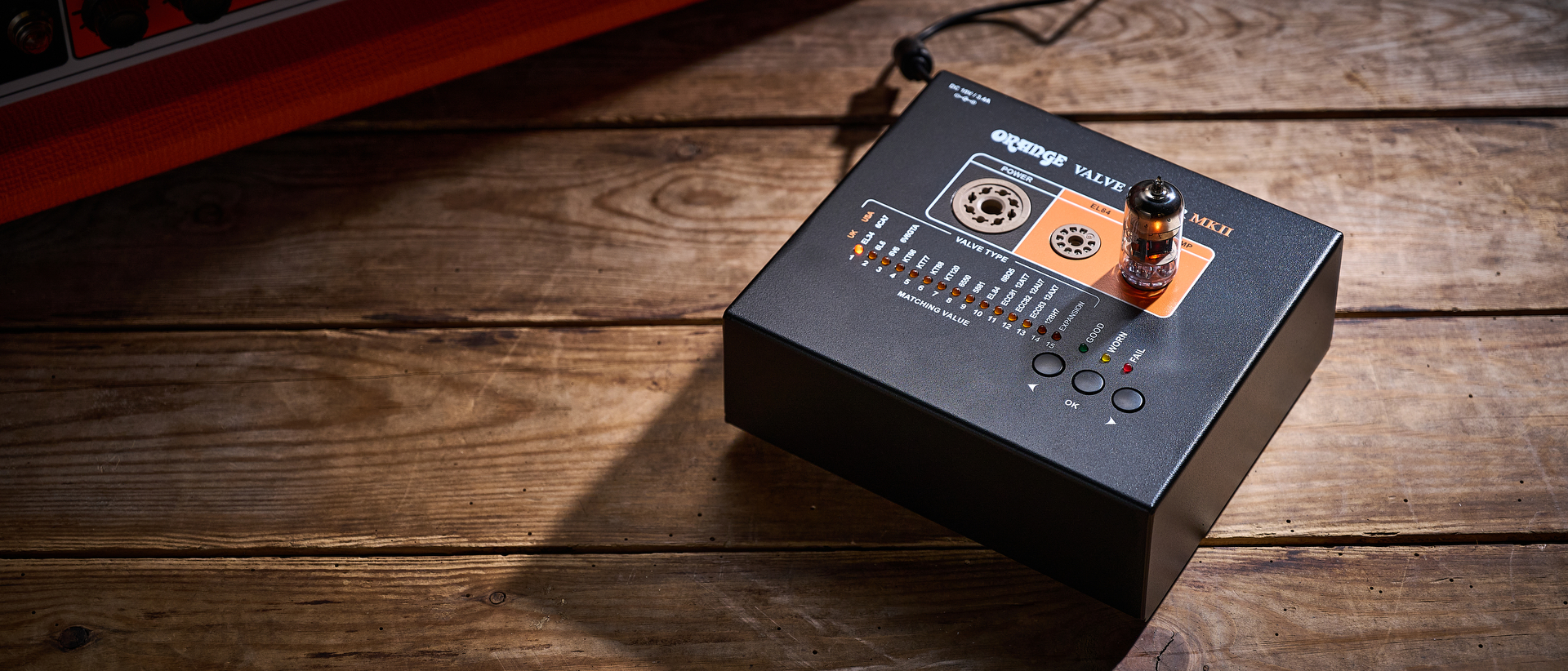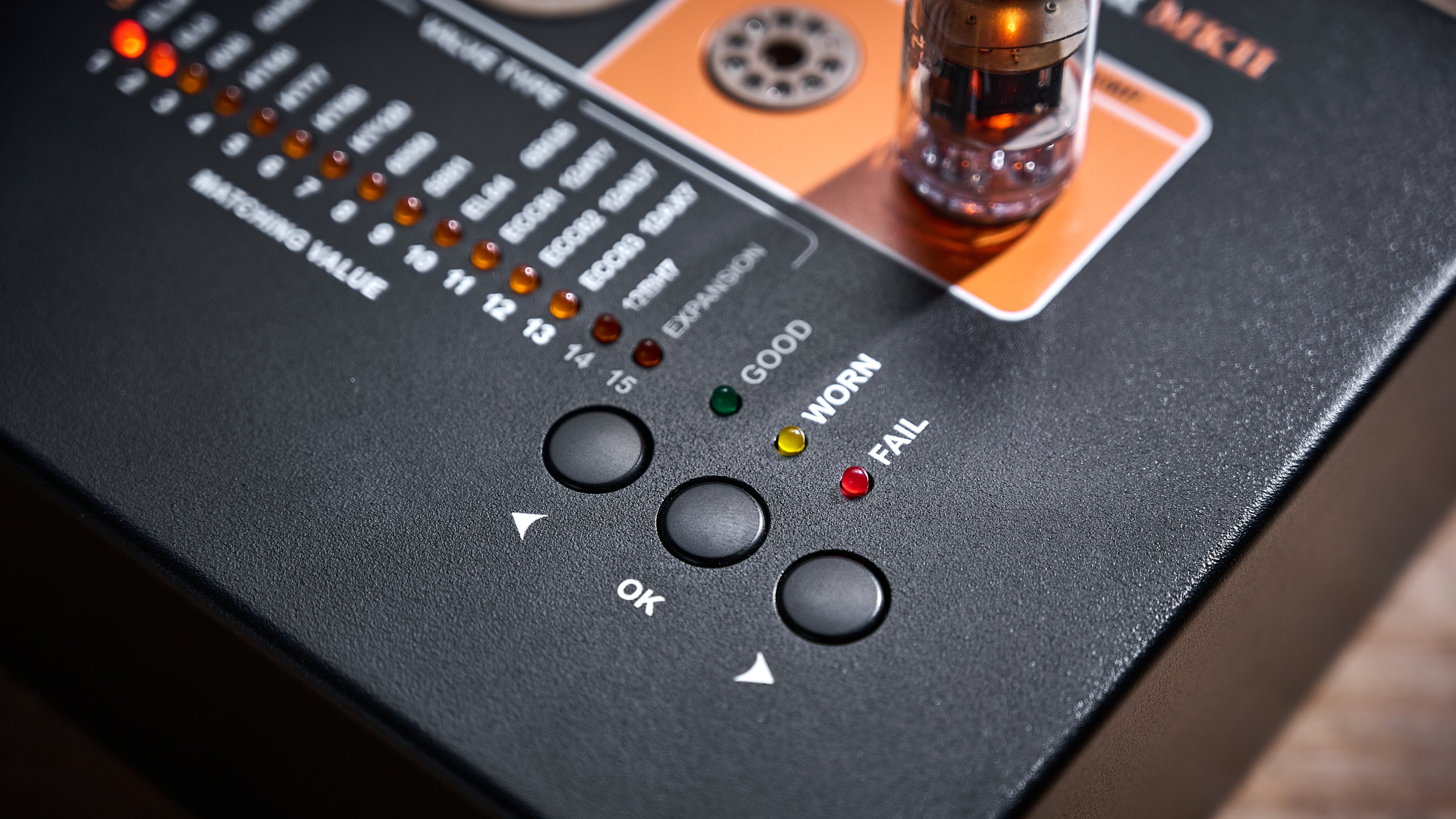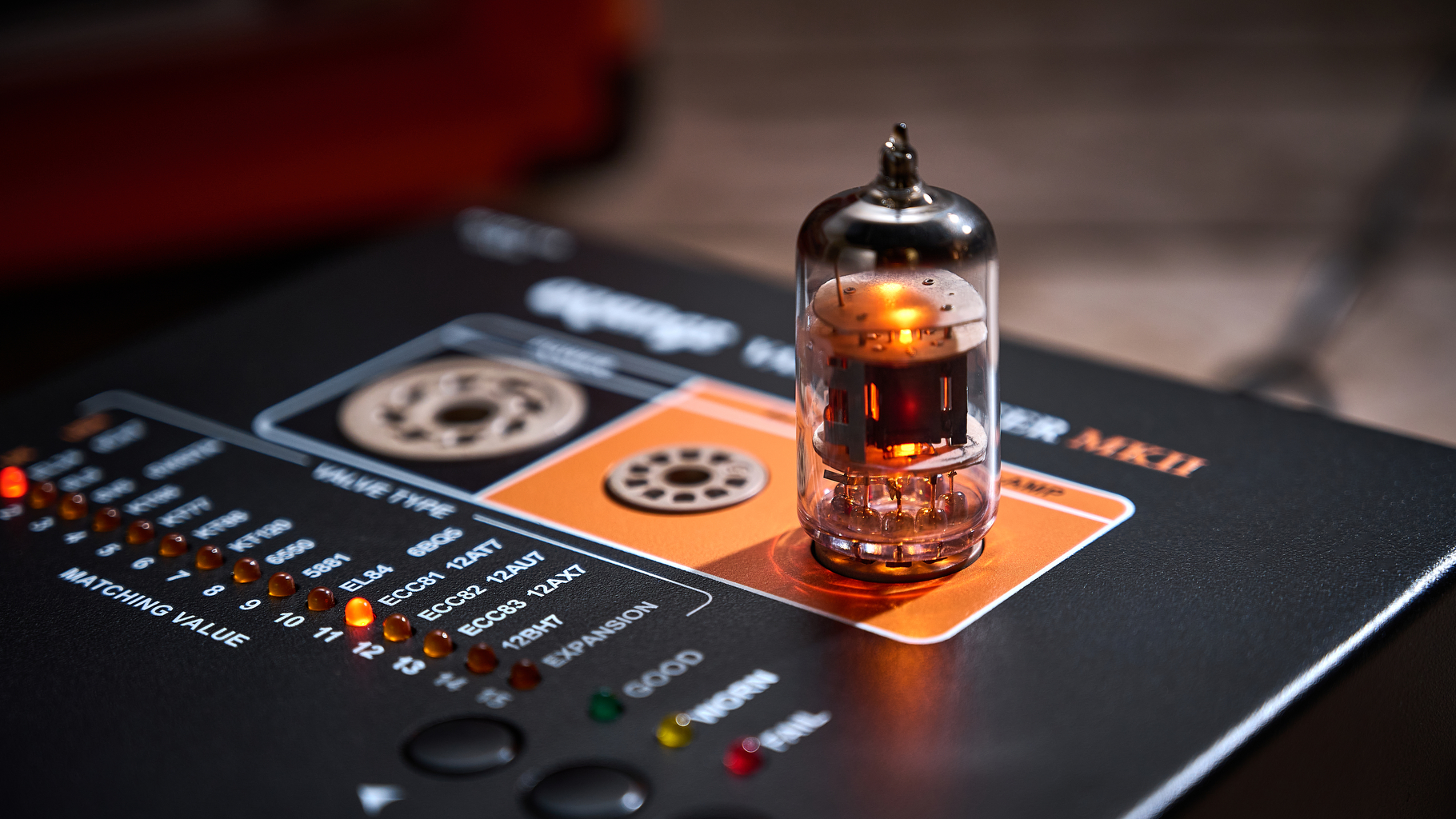Get the most from your tube amp with the Orange Valve Tester MKII
Take care of your tubes, and your amp will take care of itself. Here's how simple regular testing and inspection can help keep your amp in road-ready condition

Tubes are the beating heart of great guitar tone. Their job couldn’t be more crucial – they amplify the tiny electrical signal from your electric guitar’s pickups, turning it into a rich, vibrant amp tone that’s loud enough to get a club on its feet. The warm glow of these glass tubes inside an amp is a reassuring sign that it’s ready to deliver pro-quality tone.
But tubes (also known as valves in the UK) can wear out and lose their mojo over time, until the performance of your amp starts to seriously suffer as a result. Unwanted buzzes and crackles, loss of volume, and a flat playing ‘feel’ are all unwelcome gremlins that can be caused by tubes that are past their best. That’s where Orange’s ingenious Valve Tester MKII comes in – offering a quick, user-friendly method to check the health of tubes and diagnose problems in moments.
To learn more about how using a testing device can keep your amp tone in peak condition – and how to spot problems developing that may need testing – we sat down with Jon Radford, senior workshop technician with Orange Amps to find out more…
Why test your tubes?

There are numerous benefits to testing valves. Most tube amps contain multiple tubes in both the preamp stage of the amp (where gain and EQ is adjusted) and in the power stage, where the heavy lifting of amplification takes place.
Isolating a problem by trial and error can be a thankless task with no guarantee of diagnosing the problem correctly. Rather than replace an entire set of tubes to solve what may be a localised problem, the Tester allows you to replace only the tubes that really need it, when they need it – potentially saving you hundreds of pounds over time – clearly indicating the condition of a tube under test with a ‘good’, ‘worn’ or ‘fail’ reading.
As Jon explains, when one valve in a set isn’t generating as much gain as the others, it forces the rest to work harder, leading to faster burnout and failure rates.
“In most guitar amps, there’s an A/B push-pull scenario. So you’ve got a signal - like a sine wave - that’s going from positive to negative and one side of the power stage of the amp will ‘push’ while the other ‘pulls’,” says Jon.
“So you want those to be the same strength, so it’s distributing the work evenly (between the tubes). And you’ll find if you put a mismatched set into your amp, there’ll always be one or two of those – in a quad for example – that are working harder than the others so you’ll get premature failure of one valve and then you’ve got to change the whole set.”

The Orange Valve Tester MKII allows you to test for mismatches in gain between tubes in a set, allowing you to prevent such failures happening. This also applies to mismatches in gain occurring within common valves such as 12AX7s, which have two functional halves (triodes) inside one tube, each performing a separate amplifying task.
These halves can become out of balance, and when used in a phase inverter circuit, it's important advisable to swap that both sides of the tube are producing an equal amount of gain. Again, the Orange Valve Tester MKII can spot this and allow you to take timely action.
Also, increasing numbers of players want the tonal benefits of using New Old Stock (NOS) valves from the heyday of tube amplification, such as Mullards or RCA tubes. These can be very expensive on the secondhand market, so taking a portable tester with you to try NOS tubes before purchase can help you avoid buying duds and wasting your money.
Designed to be used by guitar players and hi-fi enthusiasts, not just technicians, the Orange Valve Tester MKII is simple and intuitive to use and you don’t need to consult complex charts or technical manuals to interpret its findings. And with a range of expansion modules now available (adaptors to allow testing of rectifier tubes not just preamp and power tubes) there isn’t much the Orange Valve Tester MKII can’t tackle.
In short, if there’s an issue with a tube that may affect the tone or performance of your amp, the Orange Valve Tester MKII will enable you to diagnose it in seconds before it causes damage, ruins a gig or hurts your pocket.
Recognizing tube issues

While a specialist device such as the Orange Valve Tester MKII is the best way to diagnose tube problems, there may be tell-tale signs that something is amiss that can be heard and felt by the player.
“I guess the main thing you might notice is just a drop in volume,” Jon Radford says. “People might notice that where they might have had the amp volume turned up to 3 or 4, now they’re having to turn up to 4 or 5 to achieve the same volume.”
This volume drop is typically caused by the power tubes reaching the end of their lifespan and this can also affect how the amp feels to play and how it reacts to player input.
“There are other more subtle things where the amp may seem like it’s overly compressing – like its sound is folding in on itself when you push it,” Jon adds.
“You’ll get a sense of the sound of it not being right but also the feel of it being wrong.”
Another symptom of defective tubes is unwanted noise, Jon says, an issue that can affect both power tubes and the smaller tubes in the preamp section of the amp.
“You might experience noises like frying bacon or rustling noises – and microphonic valves might even produce a whistling, ringing noise, so you get an unwanted overtone,” Jon says, referring to a common problem that causes defective valves to amplify physical vibrations, including those generated by the amp itself while in use, leading to feedback issues, and potentially amplifying radio-frequency interference to an unacceptable degree as well. These microphony issues are detectable by the Orange Valve Tester MKII, allowing you to identify and weed out problem tubes more easily, accurately and reliably than by manual testing.
"Your tube amp isn't trying to kill you!"

Just like lightbulb sockets, the vast majority of tube amps are designed to allow you to replace the valves without any danger of electric shock. If you stay aware of some simple rules, changing them yourself should be a breeze and perfectly safe.
“I think with valve amps in general there’s this notion that your valve amp’s trying to kill you,” Jon smiles. “Obviously there’s a safe way to work around a valve amp but there should be no danger for people to change their own valves themselves. It’s the internals of the amp – the circuitry – that they should avoid touching,” Jon says.
Typically, tubes are mounted on the outside of the amp’s chassis. The chassis is the metal ‘box’ that contains the amp’s circuitry, including potentially dangerous components such as capacitors that can hold electrical charge even when the amp is switched off. If you remove the chassis from the amp, the side containing the circuitry will now be open to inspection. You should carefully avoid touching anything that lies inside this part of the amp. But, as mentioned, tubes are normally mounted on the outside of the chassis for safe, easy access and are typically removable and replaceable without any need to remove the chassis from the amp cabinet or head itself.
“Before changing valves, make sure that the amp is unplugged and that the valves aren’t hot,” Jon advises. “So don’t be changing valves straight after playing the amp.
"Also, much like plugging a wall plug into a socket, don't hold the pins as you plug the tube in just in case there is any residual charge left in the amp."
Common tube mistakes

There are many unhelpful myths surrounding tubes and how to maintain and replace them, Jon says. One persistent myth is that you shouldn’t touch the glass exterior of a tube for fear that natural oils on your skin will cause the tube to fail when in use.
“It would if the valves were operating at very high temperatures, such as in radar or cathode ray devices,” Jon says, “But guitar amps don’t operate at those high temperatures so the oil doesn’t get hot enough to hurt the glass. Obviously don’t have filthy hands covered in fried chicken grease,” he grins, “But generally speaking, it’s fine to touch the glass.”
Another myth Jon lays to rest is that a tube blowing (failing while in use) is an electrically hazardous event.
“Like a lightbulb, when it fails it just fails. If the tube shorts inside it’ll just blow an HT fuse inside the amp,” Jon says. “That’s often an indication that a power valve has gone. But it’s not going to hurt you, the amp is designed to be extremely safe even in a fail state.”
Make your tubes last longer

As with old-fashioned filament lightbulbs, it’s impossible to say when a valve will reach the end of its life and quit working.
“Preamp valves can last a year - maybe less - or keep going for decades,” Jon says. “It’s more about luck: sometimes valves are made really well and they last ages and many of the older preamp valves are like that. I come across preamp valves that are 50 years old that still work great.”
“So I’d say power valves are the ones that get worn out quickest,” Jon says, which makes sense as power tubes handle the highest voltages when the amp is in use, though the type of amp and how it is set up also influences how long power tubes will typically last.
“On some amps designed for metal, most of the gain and saturation is generated in the preamp stage, so the power valves are not being stretched very much and they’ll last ages,” Jon says, adding that if the bias – the current passing through the power tubes when the amp is switched on but with no signal from your guitar running into it - is set relatively low (known as a ‘cool’ bias) the tubes will tend to last longer, though your amp may sound a little colder and less lively than if the tubes are biased hot.
“But in an amp that’s cathode biased (self-biasing) or where you’re driving the power stage hard, it’s going to wear out quicker,” Jon adds. “So it’s difficult to put an exact time on things - it’s more a case of using your ears and listening if you notice a change or you notice the feel is different.”
So is there anything you can do, beyond regular testing, to ensure your valves last longer?
“In terms of preserving valve life, it’s not a good idea to leave an amp in ‘standby’ mode for extremely long periods of time,” Jon says. “It’s better to leave it ‘on’ in playing mode than in standby for hours on end.
“If you're having an hour-long break, I’d simply turn the amp off,” Jon adds. “Putting it in standby for any length of time causes a thing called cathode poisoning which is basically a coating inside the cathode [an important internal component of the tube] that over the lifespan of a valve will come away from the cathode and it causes a situation where the valve deteriorates much quicker.
"So standby is good just to change guitars over or something or if you need to step away from the amp for a couple of minutes, but for long periods of time just turn it off.”
• For more information on the Orange Valve Tester MKII, visit the Orange Amps website
All the latest guitar news, interviews, lessons, reviews, deals and more, direct to your inbox!


